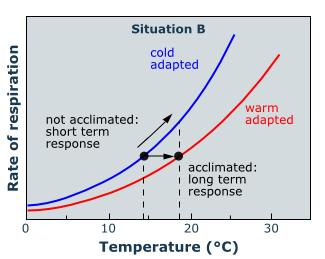Respiration of alpine plants
All non-green tissue (roots, rhizomes, flowers) respire CO 2 continuously; all green tissue also loses CO2 in the dark ("mitochondrial" or "dark" respiration). During light hours, the respiratory loss by green parts is masked by photosynthetic CO2 uptake. On average, half of all CO2 taken up during a day is respired back to the atmosphere. In contrast to photosynthesis, which is largely driven by light, the major driver of mitochondrial respiration is temperature.
Is the respiratory burden of alpine plants smaller (cool nights) or is it higher (long dormant, non-active season) than in lowland plants? To answer these questions, the temperature response of respiration must be understood.
Fig. 1 (situation A) shows the instantaneous response of mitochondrial respiration to an increase in temperature.
Note: The rate of respiration (R) increases exponentially with temperature. The average increase for a 10 K rise in temperature is about twofold. So R is twice as high at point 2 as compared to point 1. The exact ratio (the so called Q10) for alpine plants was found to be 2.3. However, in the plants occurring highest in the Alps, this ratio is between 3 and 5, a world record so far. These plants are able to respire adequately at very low temperatures by increased numbers of mitochondria, but "burn off" carbon at excessive rates if it gets too warm for them. This is the reason why no alpine rock garden can exhibit Ranunculus glacialis and other high elevation specialists. They cannot bear the heat because of rocketing respiratory losses.
The long term response of respiration is very different from the short term (instantaneous) response, because plants "acclimate" rapidly to a new temperature: If a cold adapted plant is moved to a warm temperature it adjusts its respiratory machinery in such a way that the rate of respiration is roughly maintained or only slightly increased (Fig. 1, situation B).
Remember: Because of the predominantly cold nights alpine plants lose less carbon by night respiration than lowland plants. During warmer periods they can acclimate. Measurements have shown that the overall respiratory loss of CO2 by alpine plants is similar or lower than in lowland plants.

